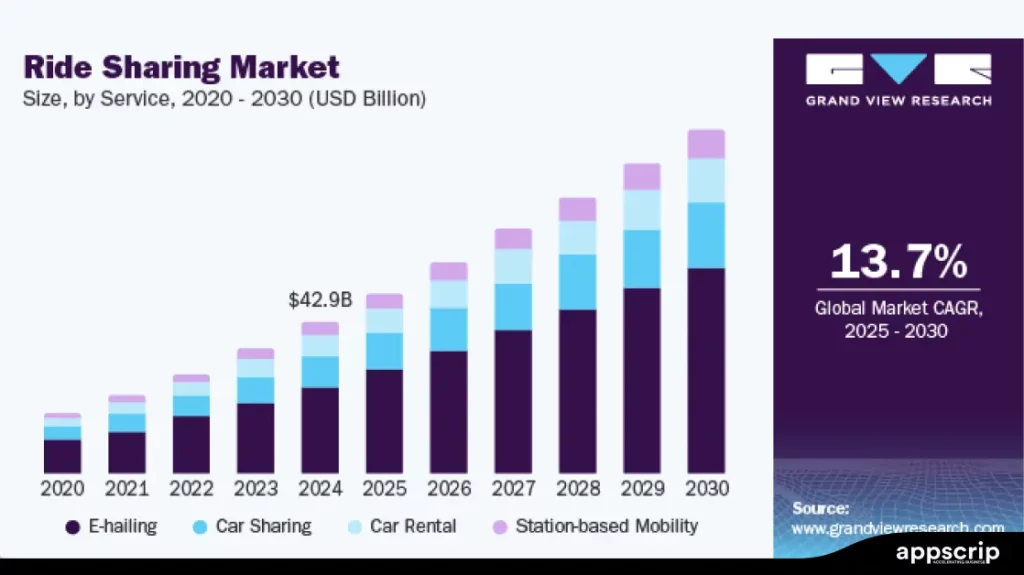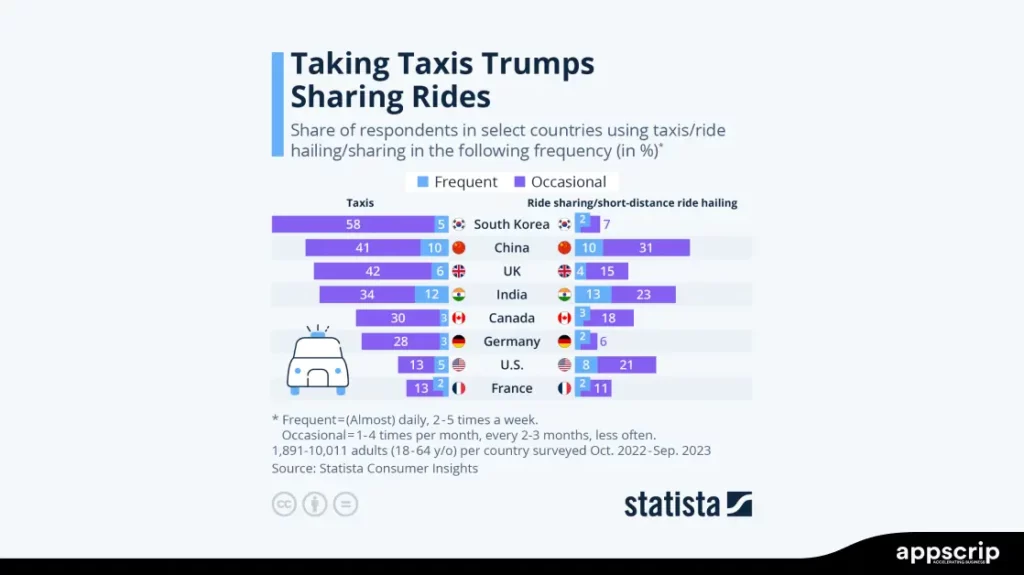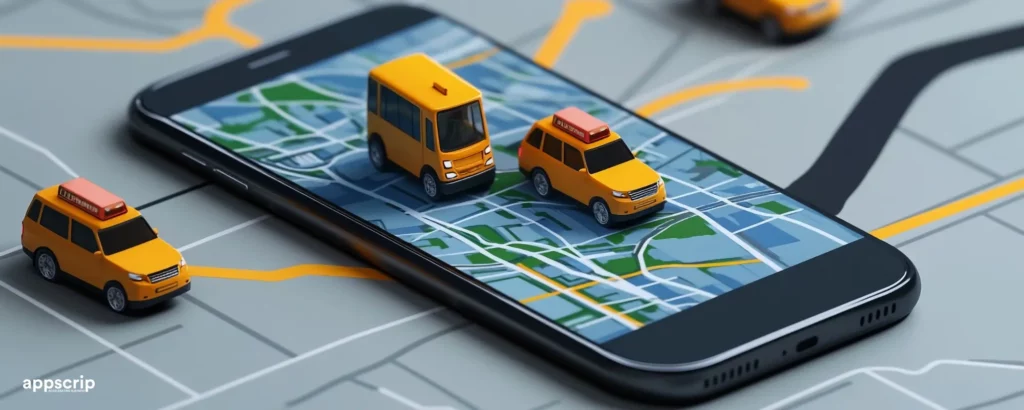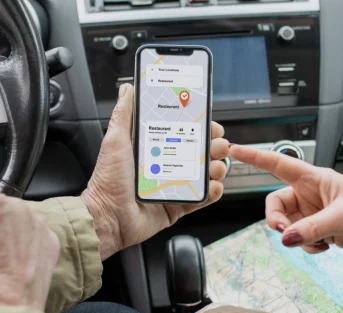There is a rapid shift occurring in the ride-hailing market, and the rules are no longer being established by multinational corporations such as Uber and Lyft. Local taxi services and independent ride-hailing businesses are becoming more popular because they offer more choices, better service, and lower prices, which attracts customers. According to projections, the ride-hailing market would be valued $212 billion by 2029.
Fleet owners and entrepreneurs who depend on third-party apps have to deal with a lot of problems, such as high commission fees, limited branding, and they are not able to control pricing or business operations. This is the reason why an increasing number of businesses are transitioning to custom taxi dispatch software, which allows them to take control over every aspect of the operations.
The success of local ride-hailing apps is credited to their affordable pricing, personalized services, and increased reliability when you compare it to major platforms. With pre-built taxi software, businesses can launch quickly, skipping the long and expensive development process. Real-time booking, automated dispatching, GPS tracking, and several payment choices are just ready to go and will help you to start operations right away.
Whether you’re an upcoming startup trying to get into the ride-hailing market or an existing one preparing to scale, finding the right taxi dispatch software solution can assist you save money, operate more efficiently, and compete with the big guys and the up-and-coming rivals.
This blog breaks down the best alternatives to taxi software like Uber, detailing their features, benefits, and ideal business use cases, so you can make the smartest choice for your ride-hailing business.
TL;DR
- Taxi software like Uber gives businesses control over pricing, branding, and operations without high commission fees.
- AI-powered dispatching improves efficiency by optimizing ride assignments, predicting demand, and reducing wait times.
- Local ride-hailing businesses are gaining traction by offering better service and competitive pricing.
- Key components of taxi software include real-time GPS tracking, automated dispatch, payment integration, and admin controls.
- Pricing models vary between one-time payments, subscriptions, and commission-based structures, each suited for different business needs.
- B2B applications include fleet aggregation, corporate transport, airport transfers, event management, and last-mile delivery.
- Choosing the right taxi dispatch software helps businesses streamline operations, increase revenue, and scale efficiently.
What Is Taxi Software Like Uber?
Taxi software is an app that helps businesses run their own ride-hailing services. It acts as a bridge between passengers with drivers, making it easy to book rides, track trips, and handle payments.
Usually, a taxi booking system comprises three essential elements:
- Passenger App: This is the app component which the customers use to book a ride. They can choose their pickup and drop-off locations, see estimated fares, track their driver, and pay through cash, card, or a digital wallet.
- Driver App: The driver app tracks daily earnings, gets turn-by-turn directions to pickup locations, and assists with ride request approval. Additionally, drivers can receive feedback from customers and choose their availability through certain platforms.
- Admin Panel: This is the control center for business owners. It lets them manage drivers, monitor trips, adjust fares, and analyze data to make smarter decisions.
With on-demand taxi software, businesses are free to operate as they see fit, in contrast to Uber and other similar platforms. Whether it’s a big fleet or a little cab business, a personalized software solution guarantees better control, more profit, and a service catered to the needs of customers.
List of Key Components
A successful taxi booking platform needs to offer a smooth experience for passengers, drivers, and fleet owners. Here are the key components of on-demand taxi software that make it all work:
Real-time GPS Tracking
Location tracking is like the most important component of any taxi service.
- Passengers can track their driver in real time, reducing uncertainty and making trips more predictable.
- Drivers get turn-by-turn navigation, helping them take the best routes and complete more rides in less time.
- Fleet owners can monitor fleet movement, reduce idle time, and optimize dispatching based on real-time demand.
AI-Powered Features & Automation
AI is changing the game in ride-hailing, making services faster, smarter, and more profitable.
- Predictive Demand Forecasting: AI analyzes past ride trends, traffic, and weather to predict where ride requests will spike. This helps businesses position drivers where they’re needed most, reducing wait times and maximizing earnings.
- Automated Dispatching: AI assigns rides to the nearest available driver instantly, minimizing idle time and ensuring quick pickups. This means no more manual ride allocation.
- Smart Surge Pricing: AI detects demand fluctuations and adjusts fares dynamically, increasing earnings during peak hours while keeping rides available for passengers.
- Driver Behavior Insights: AI tracks driving patterns, customer ratings, and efficiency metrics to help businesses improve driver performance and safety.
Driver App Features
A driver’s app needs to be simple, effective, and provide the drivers with features that help them work efficiently.
- Ride Requests & Navigation: Instant trip alerts with built-in GPS navigation ensure drivers get to passengers faster.
- Earnings & Trip History: Drivers can easily track their daily earnings, completed rides, and upcoming payouts.
- Availability Control: Drivers can go online or offline anytime, giving them the flexibility to work when they choose.
- Ratings & Reviews: Passenger feedback helps maintain service quality and rewards top-performing drivers.
- SOS Button: Quick emergency alerts provide safety for drivers on the road.
- Trip Queue System: Keeps drivers engaged with back-to-back trips, reducing downtime and maximizing earnings.
Passenger App Features
A hassle-free experience for passengers ensures more repeat customers.
- Easy Ride Booking: A few taps to select pickup and drop-off locations, get fare estimates, and confirm rides.
- Multiple Payment Options: Cash, cards, and digital wallets provide flexibility.
- Live Ride Tracking: Passengers can see their driver’s location and estimated arrival time in real time.
- Ride History & Digital Receipts: Keeps past trip details handy for easy expense tracking.
- Ride Customization: Options for different ride types, shared rides, and scheduled bookings.
- Multi-Stop Rides: Passengers can add extra stops during their journey for convenience.
Admin Panel Features
The admin panel is where businesses control every part of the operation, ensuring efficiency and profitability.
- Fleet & Driver Management: Add, remove, and track drivers while ensuring compliance with company policies.
- Trip Analytics & Reports: Get insights into ride frequency, revenue trends, and customer preferences.
- Fare & Commission Settings: Adjust pricing, introduce surge pricing, and manage driver commissions.
- Promotions & Discounts: Create referral programs, promo codes, and seasonal discounts to attract new customers.
- Customer Support Tools: Handle ride disputes, refunds, and service issues with built-in communication tools.
- Automated Driver Onboarding: Streamlined document verification and approval process for new drivers.
- Trip Dispute Resolution: Efficient handling of fare discrepancies, ride cancellations, and complaints.
Payment Integration
- Secure Transactions: Supports multiple payment options with encrypted security.
- Automated Fare Calculation: Ensures fair pricing based on distance, time, and demand.
- Driver Payouts: Flexible payout schedules let drivers cash out earnings daily, weekly, or monthly.
- Refund & Dispute Handling: Quick resolution of payment issues increases passenger trust and satisfaction.
Benefits of Using Taxi Software for Businesses
Businesses and fleet owners that invest in on-demand taxi software gain multiple advantages, from cost savings to better fleet management. A customizable taxi software allows businesses to manage operations on their own terms, eliminating the need for third-party platforms and restrictive commission-based models.
Better Fleet Management
Managing a taxi business manually can be time-consuming and prone to errors. A taxi dispatch software automates trip assignments, tracks driver locations, and optimizes routes to reduce fuel costs and wait times.
- Real-time tracking allows businesses to monitor drivers and ensure they follow the most efficient routes.
- Automated dispatching ensures quick ride allocation, minimizing idle time for drivers.
- Performance analytics help identify top-performing drivers and areas for improvement, helping businesses refine operations.
- A system that provides built-in automation and full control allows businesses to scale operations while maintaining efficiency. Automated fleet tracking can reduce idle time by up to 30%, improving overall productivity.

Increased Revenue Opportunities
A well-designed taxi booking platform can help businesses maximize earnings through dynamic pricing, targeted promotions, and commission-based models.
- Surge pricing adjusts fares based on demand, increasing revenue during peak hours. Companies that use surge pricing models report revenue boosts of up to 20%.
- Multiple payment options make it easier for passengers to pay, reducing transaction friction.
- Loyalty programs and discounts encourage repeat bookings and customer retention.
Improved User Experience
Passengers expect fast, reliable, and hassle-free rides. A smooth user experience can increase bookings and customer satisfaction.
- Easy ride booking with just a few taps enhances convenience.
- Live tracking provides real-time updates on driver location and estimated arrival time.
- Multiple ride options allow passengers to choose from standard, executive, or shared rides.
- With a fully branded and user-friendly interface, businesses can create a seamless experience that reflects their brand identity while offering customers more control over their rides.
Cost Efficiency & Reduced Overheads
Taxi software reduces operational costs by automating administrative tasks and optimizing ride allocation.
- Less dependency on manual dispatch leads to fewer errors and better efficiency.
- Automated fare calculation removes the risk of pricing disputes between drivers and passengers.
- Fuel optimization through smart route planning helps cut down expenses.
Better Business Insights
Access to data analytics helps business owners make informed decisions to improve service quality and profitability.
- Trip analytics provide insights into demand patterns and customer preferences.
- Driver performance reports help assess efficiency and service quality.
- Revenue tracking allows businesses to monitor earnings and adjust strategies accordingly.
Factors to Consider When Choosing Taxi Software
Finding the right taxi booking platform can make or break a taxi business. Here are some key factors to consider when selecting a taxi dispatch software that fits your business needs.
Scalability for Small to Large Fleets
You can start with a few vehicles, but as demand grows, the software should be able to handle expansion without performance issues.
- Fleet size flexibility – The system should allow businesses to add or remove drivers and vehicles with ease, ensuring seamless scaling as demand grows.
- Cloud-based infrastructure – A cloud-powered system ensures smooth performance, even during peak hours, without slowdowns or disruptions, keeping the business running efficiently.
- Multi-location support – If the business expands into new cities or regions, the software should accommodate multiple locations under one platform, making it easy to manage operations in different areas.
Customizability for Unique Business Needs
Every taxi business operates differently, so the software should be flexible enough to match specific business models and branding.
- Adjustable fare structures – The ability to set dynamic pricing based on distance, time, demand, or flat rates for special services, ensuring businesses have control over their pricing models.
- Branding and white-label options – Customizing the app with the company’s logo, colors, and themes ensures a unique brand identity that strengthens customer loyalty.
- Ride options and service types – Whether offering standard rides, executive cars, shared rides, or subscription-based services, the platform should support various ride types, allowing businesses to cater to different customer preferences.
- A flexible taxi software solution helps businesses stand out by offering tailored services that match their vision without being restricted by third-party limitations.
Pricing Models
Understanding software pricing helps businesses avoid unexpected costs and choose a plan that fits their budget.
- One-time payment models – Ideal for businesses that want full ownership and control without ongoing fees. This option provides a cost-effective long-term investment.
- Subscription-based plans – Suitable for those who prefer lower upfront costs while receiving regular updates and support. This ensures the software stays up-to-date.
- Commission-based structures – Best for startups or businesses that prefer a pay-as-you-earn model. This allows them to scale their investment as revenue increases.
User Experience for Drivers and Passengers
An easy-to-use system makes a huge difference in customer satisfaction and driver retention.
- Simple onboarding for drivers – Quick registration, document uploads, and approval processes allow drivers to start earning faster, reducing downtime.
- User-friendly interface – The app should be intuitive for both drivers and passengers, reducing the learning curve and support requests, making the platform easy to adopt.
- Navigation and ride tracking – Accurate GPS tracking helps drivers reach passengers quickly and ensures customers can monitor their rides in real-time, adding transparency to the experience.
- Multiple payment options – Offering cash, card, and digital wallet payments improves convenience for passengers and ensures faster payouts for drivers, increasing user satisfaction.
Post-Sales Support and Updates
- 24/7 customer support – Quick response times help businesses resolve any technical issues without downtime, ensuring seamless operations.
- Frequent software updates – Security patches, bug fixes, and feature enhancements ensure the platform remains competitive and up-to-date with industry trends.
- Training and onboarding assistance – Comprehensive guides and dedicated support teams make it easier to train staff and drivers, ensuring businesses get the most out of their investment.
Top 10 Alternatives to Uber-Like Taxi Software
Below are the top 10 alternatives to Uber-like taxi software, each offering different features, pricing models, and ideal use cases.
Jugnoo
Jugnoo started as an auto-rickshaw hailing platform but has evolved into a complete ride-hailing and delivery solution. It’s a budget-friendly option that helps small fleet owners and taxi startups optimize their services with automated dispatch, real-time tracking, and customer engagement tools.
If you’re looking for an affordable solution that can scale with your fleet size, Jugnoo is a strong contender. It also supports multi-service operations, allowing businesses to manage both ride-hailing and delivery under one platform.
- Best for: Small fleet owners, new taxi startups, and businesses offering both rides and delivery.
- Pricing model: Starts at $48 per month (billed annually).
TaxiCaller
TaxiCaller is built for traditional taxi companies looking to digitize their dispatch operations. Their cloud-based system helps manage ride assignments efficiently while keeping costs low with a per-vehicle pricing model.
It will be perfect for small and mid-sized fleets that want an easy-to-use, affordable dispatch system without a complete overhaul. With automated ride dispatching and multi-payment integration, TaxiCaller makes it easier for taxi businesses to compete with modern ride-hailing services.
- Best for: Established taxi operators and small to mid-sized fleets.
- Pricing model: Starts at $28 per vehicle per month.
Limo n’ Taxi
For entrepreneurs targeting high-end clientele, Limo n’ Taxi is designed specifically for luxury transportation services. It supports VIP bookings, pre-scheduled rides, and seamless invoicing for corporate accounts.
If you’re building an executive ride-hailing service or limousine rental business, this platform offers the premium tools you need. It ensures high-end client satisfaction with customizable ride options, high-quality service management, and an intuitive scheduling system.
- Best for: Luxury ride services, executive transportation, and limo rentals.
- Pricing model: Custom pricing based on fleet size and business needs.
INSOFTDEV
INSOFTDEV combines AI-driven dispatching with advanced fleet analytics, making it a strong choice for large taxi businesses and enterprise fleets. It automates ride matching, improves efficiency with data-driven reports, and optimizes driver allocation in real time.
If you’re running a large-scale operation and need automation and business intelligence, INSOFTDEV can help maximize your fleet’s potential. The platform also integrates CRM tools, making it ideal for corporate fleets that require enterprise-level management.
- Best for: Large fleets, corporate taxi businesses, and AI-driven ride-hailing services.
- Pricing model: Custom pricing based on business size.
Sherlock Taxi Solution
Sherlock Taxi Solution is a white-label software that lets entrepreneurs create a fully branded ride-hailing platform. It offers real-time tracking, fare customization, and multi-platform support, making it ideal for businesses looking to build a custom ride-hailing service without the constraints of third-party apps. With full control over branding, pricing, and app functionality, this platform is best for those wanting to establish a distinctive presence in the industry.
- Best for: Entrepreneurs looking for a branded, fully customizable ride-hailing platform.
- Pricing model: One-time payment with optional ongoing support.
Ryde
Ryde focuses on eco-friendly ride-hailing, offering a carpooling-first approach that reduces fuel consumption and trip costs. They have a ride-matching algorithm that helps passengers share rides while keeping fares competitive. If you’re an entrepreneur looking to build a sustainable transportation business, Ryde’s ride-sharing model could be the key to differentiation. The platform is especially useful for businesses targeting urban areas where demand for affordable, eco-friendly travel is high.
- Best for: Carpooling services, eco-friendly transport startups, and sustainability-focused businesses.
- Pricing model: Subscription-based with per-ride pricing.
Grab Clone by TeamTweaks
Grab Clone is a pre-built ride-hailing app that allows businesses to launch a fully functional ride-hailing service quickly. It includes all the essential features, driver and passenger apps, multi-language support, and automated notifications making it ideal for startups looking for a plug-and-play solution with minimal development time. Its quick deployment and user-friendly design help businesses hit the market fast, reducing the time and cost required for app development.
- Best for: Startups looking to enter the ride-hailing market quickly.
- Pricing model: One-time purchase with optional add-ons.
Agicent Solutions
Agicent Solutions specializes in custom app development, allowing businesses to build ride-hailing platforms from the ground up. It offers total flexibility in design, pricing models, and features, making it ideal for entrepreneurs who want complete control over their taxi app’s functionality and branding.
Unlike pre-built solutions, this option allows businesses to tailor every feature to their operational needs, making it a strong choice for unique ride-hailing models.
- Best for: Businesses that need a fully customized, high-end taxi app.
- Pricing model: Custom pricing based on project requirements.
Bolt Clone
Bolt Clone is a ready-to-deploy taxi app designed for businesses that want a fast, flexible commission-based platform. It includes rider and driver apps, an integrated payment system, and surge pricing features. For entrepreneurs who want an easy-to-launch, commission-based, Bolt-style ride-hailing business with a strong focus on affordability and scalability, this solution is ideal.
- Best for: Startups and ride-hailing businesses that prefer a commission-based model.
- Pricing model: One-time payment with optional support.
GoCatch Alternative
GoCatch is an Australia-based taxi software designed for independent operators who need a locally compliant ride-booking solution. It includes automated dispatch, pre-scheduled bookings, and built-in driver earnings tracking, making it ideal for businesses operating in regulated markets.
With strong compliance features and pre-scheduled ride options, GoCatch is an excellent choice for businesses that need to meet local government requirements.
- Best for: Taxi businesses in regions with strict local regulations.
- Pricing model: Subscription-based with different pricing tiers.
Comparison Table of Top Software
Here we compare different taxi dispatch and ride-hailing software solutions and their features.
| Software Name | Starting Price | Key Features | Platforms Supported | Best For |
| Jugnoo | $48/month | Automated dispatch, real-time tracking, analytics | Android, iOS, Web | Small taxi businesses, auto-rickshaw fleets |
| TaxiCaller | $28/vehicle/month | Cloud-based dispatch, GPS tracking, payment integration | Android, iOS, Web | Traditional taxi companies |
| Limo n’ Taxi | Custom Pricing | VIP bookings, multi-vehicle dispatch, invoicing | Android, iOS, Web | Luxury ride-hailing services |
| INSOFTDEV | Custom Pricing | AI-powered dispatch, business analytics, CRM integration | Android, iOS, Web | Large taxi businesses, corporate fleets |
| Sherlock Taxi Solution | One-time Payment | White-label customization, multi-platform support | Android, iOS, Web | Businesses needing branding flexibility |
| Ryde | Subscription-based | Ride-sharing, real-time tracking, flexible pricing | Android, iOS, Web | Sustainable transport companies |
| Grab Clone by TeamTweaks | One-time Purchase | Pre-built taxi app, multi-language support, real-time notifications | Android, iOS, Web | Startups looking for quick deployment |
| Agicent Solutions | Custom Pricing | Custom UI/UX, real-time tracking, multiple payment integrations | Android, iOS, Web | Businesses needing a tailored ride-hailing app |
| Bolt Clone | One-time Payment | Surge pricing, driver and rider apps, wallet system | Android, iOS, Web | Ride-hailing startups |
| GoCatch Alternative | Subscription-based | Pre-scheduled bookings, automated dispatch, regulatory compliance | Android, iOS, Web | Taxi businesses in regulated markets |
B2B Applications of Taxi Software
Businesses are integrating B2B taxi software into their operations to manage fleets, transport employees, and to facilitate corporate travel. Taxi software supports various industries, from fleet aggregators supplying ride-hailing platforms to companies ensuring reliable employee transportation and hotels offering seamless airport transfers.
Corporate Fleet Aggregators
Fleet aggregators supply vehicles to ride-hailing companies that do not own their own fleets. These companies manage vehicle ownership, driver operations, and maintenance, allowing ride-hailing services to focus on bookings and customer engagement. For example, Everest Fleet in Mumbai provides fleet services to Uber and Ola, handling vehicle maintenance and driver onboarding.
- Scalability and Efficiency: Fleet aggregators manage thousands of vehicles, using taxi software to automate dispatching and scheduling, ensuring optimal utilization.
- In the UK, Addison Lee provides corporate taxi services, while in the U.S., First Transit manages large-scale fleet operations for ride-hailing and shuttle services.
- Financial Benefits: Automated fleet management systems help reduce downtime, optimize vehicle routes, and streamline payment processing, increasing revenue for fleet operators.
Employee Transportation Services
Large companies invest in transportation solutions to ensure employees arrive at work on time. Corporate shuttle services use taxi software to schedule and track rides, improving reliability and efficiency. Amazon and Google operate dedicated employee transportation systems to facilitate smooth commutes.
- Automated Ride Scheduling: In India, MoveInSync integrates corporate transport with HR systems, assigning rides automatically based on employee shifts.
- Live Tracking and Safety: Companies monitor rides in real time, ensuring safe and timely transportation for employees.
- Operational Advantages: Structured transportation improves employee punctuality, enhances job satisfaction, and increases overall productivity.

Hotel & Airport Transfers
Hotels and travel agencies use taxi software to manage airport transfers and on-demand rides. These systems enable seamless booking, tracking, and payment integration, improving guest experience. Luxury hotel chains like Marriott and Hilton use taxi dispatch software for pre-arranged airport transfers.
- Guest Experience Optimization: Automated booking ensures guests receive reliable and timely transportation.
- High-End Travel Solutions: In Singapore, Chauffeur Live offers business travelers premium airport transfers with automated ride dispatch.
- Operational Efficiency: Digital payment integration and real-time tracking reduce wait times and improve overall guest satisfaction.
Logistics & Last-Mile Delivery
Ride-hailing businesses are expanding into logistics by integrating taxi software with last-mile delivery services. This allows ride-hailing drivers to transport packages in addition to passengers, optimizing vehicle utilization. Companies like Uber Eats and Bolt Food have adapted their networks to support deliveries alongside passenger transport.
- Dual-Purpose Fleets: Drivers handle both passenger trips and package deliveries, increasing their earnings.
- Expansion into Delivery Services: Platforms like SafeBoda in Africa provide both ride-hailing and delivery services, maximizing platform efficiency.
- Smarter Logistics: Taxi software assigns delivery tasks based on real-time location, reducing idle time and improving efficiency.
Event Transportation Management
Large-scale events require organized transportation solutions to handle high traffic volumes. Event organizers use taxi software to manage ride-hailing partnerships, optimize pick-up and drop-off locations, and minimize congestion. Reputed music festival Coachella collaborates with ride-hailing platforms to manage festival transportation, ensuring attendees arrive and depart efficiently.
- Crowd Management: Taxi software optimizes routes and assigns drivers strategically to reduce wait times.
- Event-Specific Solutions: In Dubai, Careem Events provides dedicated ride-hailing services for corporate conferences and exhibitions.
- Traffic Control: AI-powered scheduling and dynamic ride coordination help avoid congestion and improve attendee experience.
Conclusion
More businesses are moving toward localized taxi software to gain independence from commission-heavy platforms. Fleet owners are no longer just service providers; they are becoming key players in ride-hailing by managing their own operations, setting pricing, and offering a more personalized customer experience.
AI-powered solutions are making taxi businesses smarter by automating dispatch, predicting demand, and optimizing routes in real time. Companies that use AI-driven software see faster ride assignments, reduced operational costs, and improved driver efficiency, all of which lead to better profits and customer satisfaction.
With Appscrip’s taxi dispatch software, businesses get a scalable, fully customizable platform that includes real-time GPS tracking, automated dispatch, seamless payments, and data-driven insights. Whether you run a local fleet, corporate transport, or a taxi service, this technology helps you streamline operations and scale with ease.
If you’re ready to take charge, now is the time to invest in the right dispatch system. Build your brand, grow your fleet, and run a taxi business on your own terms with Appscrip.
Frequently Asked Questions
What is the best Uber-like taxi software for startups?
The best taxi software for startups depends on how quickly they want to launch, their budget, and how much control they need over branding and features.
A white-label solution like Appscrip’s taxi dispatch software helps startups launch quickly with automated dispatch, real-time tracking, and multiple payment options. Instead of building from scratch, they can customize the platform, set pricing, and onboard drivers immediately.
Can these alternatives handle high traffic during peak hours?
Yes, AI-powered taxi dispatch software is built to manage high demand efficiently. During peak hours, intelligent ride allocation ensures that trips are assigned to the nearest available drivers, reducing wait times and keeping operations smooth. Cloud-based infrastructure ensures that the system doesn’t slow down when ride requests surge.
Businesses using Appscrip’s taxi software can also leverage dynamic pricing to increase fares during high-demand periods, maximizing profits while ensuring better availability for passengers.
How much does it cost to develop or subscribe to taxi software?
The cost of taxi software depends on whether a business chooses a subscription-based model or a fully owned solution. Subscription plans of most taxi dispatch software typically start at $28 per vehicle per month, making them a cost-effective option for small businesses and startups.
A one-time purchase of a customizable white-label platform requires a higher upfront investment but provides complete ownership and long-term savings. For businesses that need a custom-built taxi software solution, costs will be higher due to development, testing, and maintenance.





